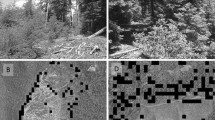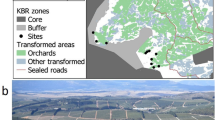Abstract
Context
In fragmented landscapes, edge influence (EI) can be an important driver of ecological change. Multiple edges can interact so that distance to the nearest edge is not an accurate predictor of EI, an issue referred to as ‘interactive EI’. This is especially important in conservation corridors, since their linear nature puts multiple edges in close proximity.
Objectives
We assess how corridor width, an important design variable in conservation corridors, influences EI on arthropod diversity.
Methods
Arthropods were sampled along the edges of grassland corridors of different widths, and from nearby protected areas (PAs) as reference. The influence of corridor width on edge-related change in arthropod diversity was assessed. This was done at the scale of single corridors, and in comparison to nearby PAs.
Results
Corridor width influences EI strength. This was apparent at the local scale, and for those species associated with the corridor interior. At the landscape scale, distance to the nearest edge was more important for the similarity of corridors to PAs than corridor width. This was driven by edge specialists rather than grassland interior species.
Conclusions
Interactive EI influences local edge responses, especially for species which avoid edges. Future assessments should incorporate processes operating across larger scales into edge responses. We show that there is much greater conservation value in larger corridors for grassland specialists than smaller corridors, and for a given area of set-aside conservation land, we support the establishment of a few wide corridors over many narrow corridors in production landscapes.

Similar content being viewed by others
References
Abouelezz HG, Donovan TM, Mickey RM, Murdoch JD, Freeman M, Royar K (2018) Landscape composition mediates movement and habitat selection in bobcats (Lynx rufus): implications for conservation planning. Landsc Ecol 33:1301–1318
Anderson MJ, Crist TO, Chase JM, Vellend M, Inouye BD, Freestone AL, Sanders NJ, Cornell H V., Comita LS, Davies KF, Harrison SP, Kraft NJB, Stegen JC, Swenson NG (2011) Navigating the multiple meanings of β diversity: a roadmap for the practicing ecologist. Ecol Lett 14:19–28
Baldissera R, Ganade G, Benedet Fontoura S (2004) Web spider community response along an edge between pasture and Araucaria forest. Biol Conserv 118:403–409
Banks-Leite C, Ewers RM, Metzger J-P (2010) Edge effects as the principal cause of area effects on birds in fragmented secondary forest. Oikos 119:918–926. https://doi.org/10.1111/j.1600-0706.2009.18061.x
Barton K (2019) MuMIn: multi-model inference
Bates D, Maechler M, Bolker B, Walker S (2015) Fitting linear mixed-effects models Using lme4. J Stat Softw 67:1–48
Benítez-Malvido J, Lázaro A, Ferraz IDK (2018) Effect of distance to edge and edge interaction on seedling regeneration and biotic damage in tropical rainforest fragments: a long-term experiment. J Ecol 106:2204–2217
Bunyan M, Jose S, Fletcher R (2012) Edge effects in small forest fragments: why more is better? Am J Plant Sci 3:869–878. https://doi.org/10.4236/ajps.2012.37104
Burnham KP, Anderson DR (2002) Model selection and multimodel inference: a practical information-theoretic approach. Springer, New York
Clarke KR, Somerfield PJ, Chapman MG (2006) On resemblance measures for ecological studies, including taxonomic dissimilarities and a zero-adjusted Bray-Curtis coefficient for denuded assemblages. J Exp Mar Bio Ecol 330:55–80
Clarke RT (2002) Confidence limits for regression relationships between distance matrices: estimating gene flow with distance. J Agric Biol Environ Stat 7:361–372
Collinge SK (2000) Effects of grassland fragmentation on insect species loss, colonization, and movement patterns. Ecology 81:2211–2226
De Cáceres M, Legendre P (2009) Associations between species and groups of sites: indices and statistical inference. Ecology 90:3566–3574
Euskirchen ES, Li Q, Harper KA (2006) Linking the ecology of forest edges and roads to landscape. In: Chen J, Saunders S, Broskofske K, Crow T (eds) Linking ecology to landscape hierarchies. Nova Science Publishers, New York, pp 71–88
Ewers RM, Didham RK (2006) Confounding factors in the detection of species responses to habitat fragmentation. Biol Rev 81:117–142
Ewers RM, Didham RK (2007) The effect of fragment shape and species’ sensitivity to habitat edges on animal population size. Conserv Biol 21:926–936
Ewers RM, Thorpe S, Didham RK (2007) Synergistic interactions between edge and area effects in a heavily fragmented landscape. Ecology 88:96–106
Ferna C, Acosta FJ, Abella G, López F, Dıáz M (2002) Complex edge effect fields as additive processes in patches of ecological systems. Ecol Modell 149:273–283
Fletcher RJJ (2005) Multiple edge effects and their implications in fragmented landscapes. J Anim Ecol 74:342–352
Gaigher R, Pryke JS, Samways MJ (2019) Divergent fire management leads to multiple beneficial outcomes for butterfly conservation in a production mosaic. J Appl Ecol 56:1322–1332
García-Romero A, Vergara PM, Granados-Peláez C, Santibañez-Andrade G (2019) Landscape-mediated edge effect in temperate deciduous forest: implications for oak regeneration. Landsc Ecol 34:51–62
González E, Salvo A, Valladares G (2015) Arthropods on plants in a fragmented Neotropical dry forest: a functional analysis of area loss and edge effects. Insect Sci 22:129–138
Gurka MJ (2006) Selecting the best linear mixed model under REML. Am Stat 60:19–26
Haddad NM, Baum KA (1999) An experimental test of corridor effects on butterfly densities. Ecol Appl 9:623–633
Harper KA, Macdonald SE, Burton PJ, Chen J, Brosofske KD, Saunders SC, Euskirchen ES, Roberts D, Jaiteh MS, Esseen P (2005) Edge influence on forest structure and composition in fragmented landscapes. Conserv Biol 19:768–782
Harper KA, Mascarúa-López L, Macdonald SE, Drapeau P (2007) Interaction of edge influence from multiple edges: Examples from narrow corridors. Plant Ecol 192:71–84
Harris LD (1988) Edge effects and conservation of biotic diversity. Conserv Biol 2:330–332
Joubert L, Pryke JS, Samways MJ (2016) Positive effects of burning and cattle grazing on grasshopper diversity. Insect Conserv Divers 9:290–301
Joubert L, Samways MJ (2014) Equivalence of grasslands in an ecological network and a World Heritage Site. Biodivers Conserv 23:2415–2426
Kiviniemi K, Eriksson O (2002) Size-related deterioration of semi-natural grassland fragments in Sweden. Divers Distrib 8:21–29
Lacasella F, Gratton C, De Felici S, Isaia M, Zapparoli M, Marta S, Sbordoni V (2015) Asymmetrical responses of forest and “beyond edge” arthropod communities across a forest–grassland ecotone. Biodivers Conserv 24:447–465
Lamb A, Balmford A, Green RE, Phalan B (2016) To what extent could edge effects and habitat fragmentation diminish the potential benefits of land sparing? Biol Conserv 195:264–271
Laurance WF, Nascimento HEM, Laurance SG, Andrade A, Ewers RM, Harms KE, Luizão RCC, Ribeiro JE (2007) Habitat fragmentation, variable edge effects, and the landscape-divergence hypothesis. PLoS ONE 2:e1017
Laurance WF, Yensen E (1991) Predicting the impacts of edge effects in fragmented habitats. Biol Conserv 55:77–92
Li Q, Chen J, Song B, LaCroix JJ, Bresee MK, Radmacher JA (2007) Areas influenced by multiple edges and their implications in fragmented landscapes. For Ecol Manag 242:99–107
Lukacs PM, Burnham KP, Anderson DR (2009) Model selection bias and Freedman’s paradox. Ann Insitute Stat Math 62:117–125
Malcolm JR (1994) Edge effects in central Amazonian forest fragments. Ecology 75:2438–2445
Malcolm J (1998) A model of conductive heat flow in forest edges and fragmented landscapes. Clim Change 39:487–502
Malcolm JR (2001) Extending models of edge effects to diverse landscape configurations, with a neotropical test case. In: Bierregaard RO, Gascon C, Lovejoy TE, Mesquita R (eds) Lessons from Amazonia: the ecology and conservation of a fragmented forest. Yale University Press, New Haven, pp 346–357
Malcolm JR, Valenta K, Lehman SM (2017) Edge effects in tropical dry forests of Madagascar: additivity or synergy? Landsc Ecol 32:327–341
Mancke RG, Gavin TA (2000) Breeding bird density in woodlots: Effects of depth and buildings at the edges. Ecol Appl 10:598–611
Phillipsen IC, Kirk EH, Bogan MT, Mims MC, Olden JD, Lytle DA (2015) Dispersal ability and habitat requirements determine landscape-level genetic patterns in desert aquatic insects. Mol Ecol 24:54–69
Pinheiro J, Bates D, DebRou S, Sarkar D, R Core Team (2019) nlme: Linear and Nonlinear Mixed Effects Models
Pope N (2019) corMLPE: A correlation structure for symmetric relational data. R package version 0.0.2.
Porensky LM, Young TP (2013) Edge-effect interactions in fragmented and patchy landscapes. Conserv Biol 27:509–519
Pryke JS, Roets F, Samways MJ (2016) Wild herbivore grazing enhances insect diversity over livestock grazing in an African grassland system. PLoS ONE 11:e0164198
Pryke JS, Samways MJ (2012a) Conservation management of complex natural forest and plantation edge effects. Landsc Ecol 27:73–85
Pryke JS, Samways MJ (2012b) Ecological networks act as extensions of protected areas for arthropod biodiversity conservation. J Appl Ecol 49:591–600
Pryke JS, Samways MJ (2015) Conserving natural heterogeneity is crucial for designing effective ecological networks. Landsc Ecol 30:595–607
Pryke SR, Samways MJ (2001) Width of grassland linkages for the conservation of butterflies in South African afforested areas. Biol Conserv 101:85–96
R Core Team (2019) R: a language and environment for statistical computing. R Foundation for Statistical Computing, Vienna
Reino L, Beja P, Osborne PE, Morgado R, Fabião A, Rotenberry JT (2009) Distance to edges, edge contrast and landscape fragmentation: interactions affecting farmland birds around forest plantations. Biol Conserv 142:824–838
Ries L, Fletcher RJJ, Battin J, Sisk TD (2004) Ecological responses to habitat edges: mechanisms, models, and variability explained. Annu Rev Ecol Evol Syst 35:491–522
Ries L, Murphy SM, Wimp GM, Fletcher RJ (2017) Closing persistent gaps in knowledge about edge ecology. Curr Landsc Ecol Rep 2:30–41
Row JR, Knick ST, Oyler-McCance SJ, Lougheed SC, Fedy BC (2017) Developing approaches for linear mixed modeling in landscape genetics through landscape-directed dispersal simulations. Ecol Evol 7:3751–3761
Samways MJ (2007) Implementing ecological networks for conserving insect and other biodiversity. In: Stewart AJA, New TR, Lewis OT (eds) Insect conservation biology. Springer, Netherlands, pp 127–143
Samways MJ, Bazelet CS, Pryke JS (2010) Provision of ecosystem services by large scale corridors and ecological networks. Biodivers Conserv 19:2949–2962
Sarremejane R, Cañedo-Argüelles M, Prat N, Mykrä H, Muotka T, Bonada N (2017) Do metacommunities vary through time? Intermittent rivers as model systems. J Biogeogr 44:2752–2763
Schultz CB (1998) Dispersal behavior and its implications for reserve design in a rare oregon butterfly. Conserv Biol 12:284–292
Smith TM, Hindell JS, Jenkins GP, Connolly RM (2010) Seagrass patch size affects fish responses to edges. J Anim Ecol 79:275–281
Soga M, Kanno N, Yamaura Y, Koike S (2013) Patch size determines the strength of edge effects on carabid beetle assemblages in urban remnant forests. J Insect Conserv 17:421–428
Swallow KA, Goodenough AE (2017) Double-edged effect? Impact of dual edge proximity on the distribution of ancient woodland indicator plant species in a fragmented habitat. Commun Ecol 18:31–36
Tichý L, Chytrý M (2006) Statistical determination of diagnostic species for site groups of unequal sample size. J Veg Sci 17:809–818
van Schalkwyk J, Pryke JS, Samways MJ (2017) Wide corridors with much environmental heterogeneity best conserve high dung beetle and ant diversity. Biodivers Conserv 26:1243–1256
van Schalkwyk J, Pryke JS, Samways MJ (2019) Contribution of common vs. rare species to species diversity patterns in conservation corridors. Ecol Indic 104:279–288
Wimp GM, Murphy SM, Lewis D, Ries L (2011) Do edge responses cascade up or down a multi-trophic food web? Ecol Lett 14:863–870
Yahner RH (1988) Changes in wildlife communities near edges. Conserv Biol 2:333–339
Acknowledgements
The authors thank Ezemvelo KZN wildlife, iSimangaliso Wetland Authority, Mondi South Africa, Mondi-Shanduka and SiyaQhubeka Plantations for permitting sampling on their holdings. Funding for this work was from Mondi Global.
Author information
Authors and Affiliations
Corresponding author
Additional information
Publisher's Note
Springer Nature remains neutral with regard to jurisdictional claims in published maps and institutional affiliations.
Electronic supplementary material
Below is the link to the electronic supplementary material.
Rights and permissions
About this article
Cite this article
van Schalkwyk, J., Pryke, J.S., Samways, M.J. et al. Corridor width determines strength of edge influence on arthropods in conservation corridors. Landscape Ecol 35, 1175–1185 (2020). https://doi.org/10.1007/s10980-020-01008-6
Received:
Accepted:
Published:
Issue Date:
DOI: https://doi.org/10.1007/s10980-020-01008-6




